How-to Make Beet Kvass // A Cleansing Medicinal Tonic
Part of my journey towards healing my body has been transitioning myself from the standard approach to food consumption that we have all grown up with, eating whatever is served to you or whatever was around and seems right or easy – to instead being able to fully tap into my innate sense of knowing what my body truly needs in the moment and nourishing it in a much more mindful way. Most effective has been the practice slowing down and quieting my mind enough to access this intuition, not just while preparing and actually eating my food, but also harnessing this skill away from meal time – in my yoga and meditation practices. It is in these moments that I truly give myself the space the fully listen to my body and trust that deep down I know what is right.
While this may to you, sound like the beginnings of a meditation series rather than a recipe tutorial, your instincts are not actually far off. For me, this ability to tap into my intuition first came by way of my yoga practice, then it was further developed in my meditation practice and now I find myself opening the fridge and not rummaging through for what I am craving and what sounds good, but rather quieting the chatter of my mind enough to really access the place where my body can communicate to me what it needs. I think in this busy and hectic world we have lost touch with this incredible primal ability to be so in tune with our body and it’s needs and I fear that we are missing out on the opportunity to truly nourish ourselves in a far more effective and meaningful way. Both in the food we eat, but also in the life that we choose to lead.
Recently I was at a new moon sound healing journey, hosted by my friend Brook. As I always do, every few weeks, I showed up for myself. To give myself the much needed time and space for self care, but to also honor my healing path, my guides, and most importantly to set an intention. In my most recent journey, a few weeks back, as we lie there drinking in the healing vibes of the beautiful sound, I found myself receiving messages about what I needed more of, what I should be following and the places that my energy would be best spent. It was powerful, moving and truthfully, it was a little scary (maybe scarier is actually typing it up and sharing it with the world, though).
While much of the messages pertained to my work with others and the new paths I am exploring in my work and as a healer, I also heard, very clearly, certain personal needs that I should explore. To receive very clear messages while meditating isn’t something new to me, but to be told what to do very loudly and very specifically in this manner, this was a first. Without boring you with of the details I will just share the part of that journey that inspired this post. The word beet and images of beets continuously appeared throughout the session. While so much was zipping past me, so many ideas, so many words and images, suddenly rising above the rest, very loudly and clearly I heard: “You need more beets” “Try a beet tonic”. I instantly was reminded of Beet Kvass, something I have tried before, but never actually made for myself.
What is Beet Kvass
Beet Kvass is a healing and cleansing medicinal tonic. A traditional probiotic drink, popular in Eastern Europe, Ukraine and Russia, it is the result of fermentation by friendly Lactobacillus bacteria, which gives it a briny, tangy flavor. Beet kvass has a very interesting flavor combination, that is certainly an acquired taste. A little more intense than the kombucha or sauerkraut we’ve all come to know, it’s earthy, salty, sour, a little sweet and it has that elusive umami flavor – sometimes it’s even a little fizzy.
Benefits of Beet Kvass:
- Rich in Probiotics
- Dense in Valuable Nutrients
- Excellent Liver Cleanser
- Beneficial Blood Tonic that Balances the pH of the Blood
- Reduces the Risk of Cancer from it’s Various Antioxidant and Anti-inflammatory Properties
Created through lacto-fermentation, this nutrient-dense stimulating tonic is loaded with friendly probiotic bacteria and beneficial enzymes, great for intestinal health, aiding in digestion and elimination, it’s an excellent liver cleanser and along with the healthy probiotics, beet’s high levels of vitamin C make this tonic an excellent boost for the immune system. It’s also more hydrating than water, containing a collection of minerals necessary to electrolyte balance in the body. Beets also contain phytonutrients called betalains that are found in the pigment of beets and are what causes your hands to stain. These betalains help create red blood cells, making beet kvass an excellent blood tonic for alkalizing the blood. Beet kvass and beets also help to naturally cleanse the gallbladder, improve bile flow, remove plenty of toxins and promote regularity!
Beet kvass can be drank as a tonic, straight up, it can be used in place of vinegar in cooking or in salad dressings, it’s also a great addition to soup and you can even use it in cocktail, the way you would a vinegar shrub.
From Sally Fallon in Nourishing Traditions (page 610):
This drink is valuable for it’s medicinal qualities and as a digestive aid. Beets are just loaded with nutrients. One 4-ounce glass, morning and night, is an excellent blood tonic, promotes regularity, aid digestion, alkalizes the blood, cleanses the liver and is good treatment for kidney stones and other ailments.
How it Works:
Traditionally beet kvass is made using a culture starter like whey (not protein powder whey, but starter whey), sauerkraut juice or sourdough starter, but it can also be made without – it will just need a bit more time to ferment.
Whichever method you choose, start with fresh, raw, organic beets. You can leave the peels on, just be sure to wash off any dirt. If you can’t get organic beets, definitely peel your beets. The beets get salt and a starter (if you are using it), it is covered with filtered water and then it is left to ferment in a jar or crock. You can also add flavors like garlic, caraway, mint, cloves, cardamom, ginger, strawberries, orange peel, etc.
I drink 4 ounces of beet kvass in the morning and when I can an additional 4 ounces in the evening.
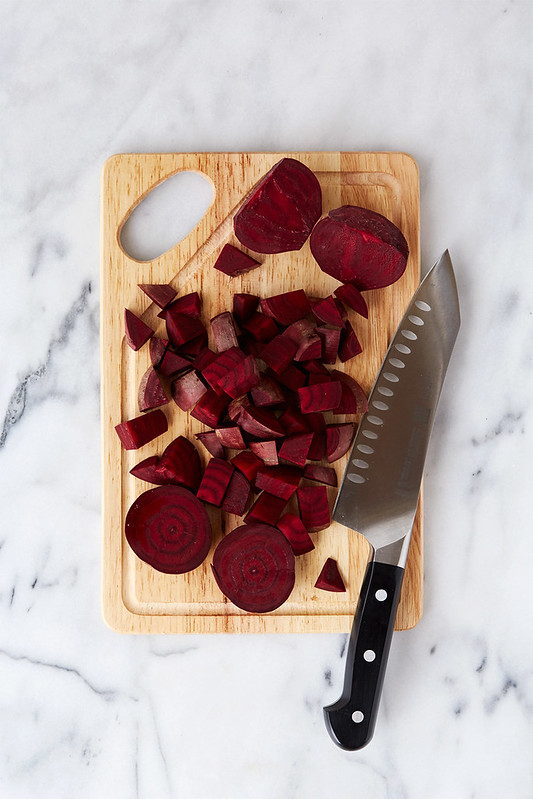
Two Methods:
With a Culture Starter:
When using a culture starter the results will be a bit less salty and the fermentation is a bit easier to control. Use 1/4 cup whey or sauerkraut juice (from non-pasteurized, preferably homemade sauerkraut). I have read that kombucha and kefir are not great starters for this, but I haven’t experimented myself with either.
Without a Culture Starter:
For a wild fermantation, without a starter, add additional salt. 1/2 tablespoon more, for a total of 1 1/2 tablespoons. Allow the beet kvass additional time to ferment.
How-to Make Beet Kvass
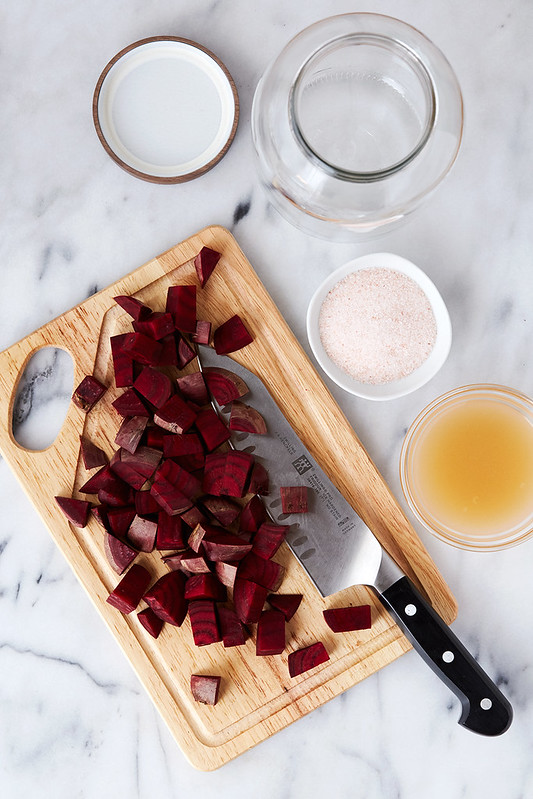
Start with 3-4 organic beets, wash well and cut into cubes. About 1/2 – 1 inch.
Add the beets to a 2 quart (half gallon) glass jar or container.
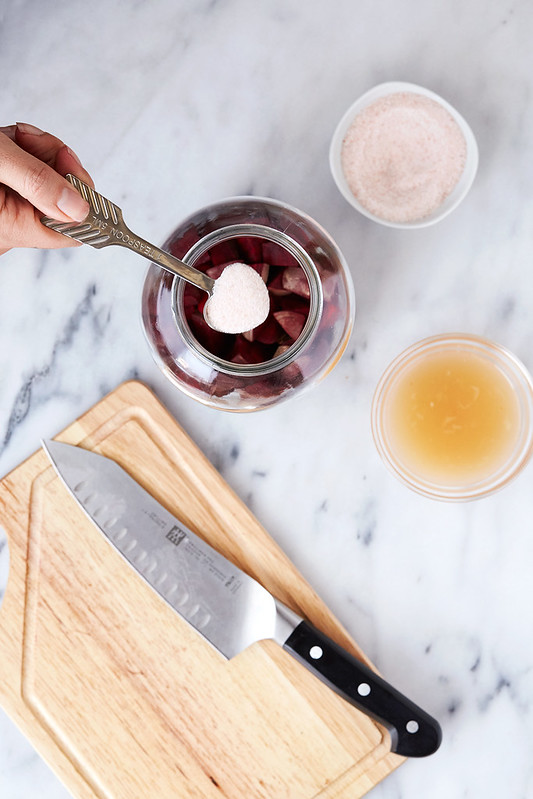
Add the sea salt. 1 tablespoon if using a culture starter, 1 1/2 tablespoons if not using a culture starter.

Add 1/4 cup of your culture starter, if using. Such as whey or sauerkraut juice.
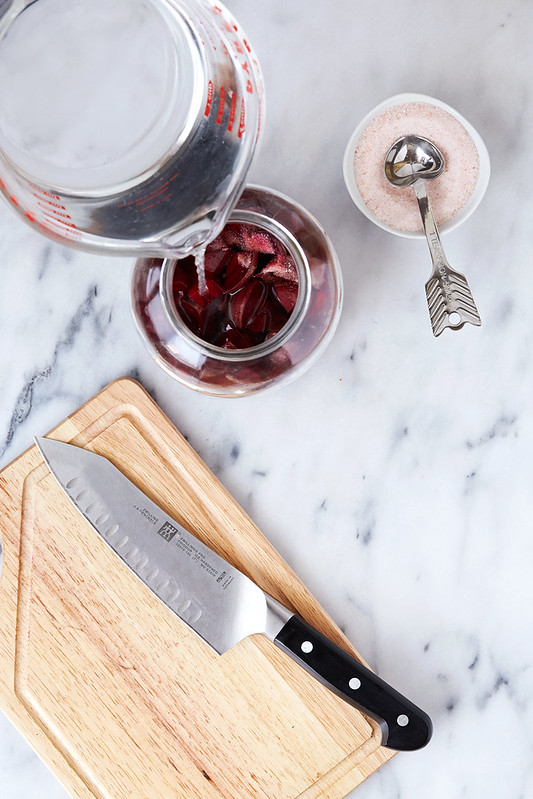
Fill the jar with filtered water. Leaving about 1 inch at the top.
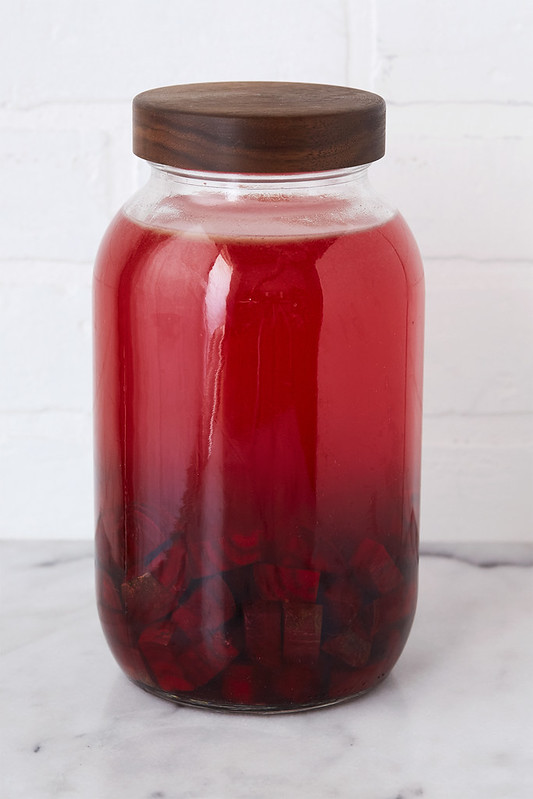
Place the lid on securely. Allow to ferment for 3- 7 days if using a culture starter or 7 to 10 days (or possibly longer) if not using a starter. It will turn to a beautiful, rich deep color and you can end fermentation when the flavor is to your liking. Transfer to the refrigerator.
Things to Note:
Sea Salt
High quality salt is important, I recommend pink himalayan salt, celtic sea salt or any unrefined salt as these contain trace minerals and are loaded with nutrients. Do not use standard table salt, the iodine that has been added will inhibit the growth of the beneficial bacteria.
Filtered Water
As always, it’s best to go with high quality, filtered water. Regular tap water generally contains chlorine, fluoride and other chemicals that can prevent fermentation from properly occurring.
White Foam/Scum
Sometimes I get a white foam or scum on top of my kvass. Nothing to fear. I just scoop it off before I put the jar in the refrigerator.
Cube the Beets, Don’t Grate
Grated beets will create too much juice, which will ferment too rapidly, producing alcohol instead of lactic acid.
Bonus – Printable Labels:
Download a customizable version of these labels to print at home to give your jar or bottle of homemade Beet Kvass an extra-special, personal touch! Print the PDF, simply write your name in under “by:” and fill in the servings. That’s it. DOWNLOAD HERE.
Print these 2.5-inch diameter labels on any Avery brand 22808 template. I used these brown kraft paper labels.
[print_this]How-to Make Beet Kvass
makes just under 2 quarts
- 3-4 medium/large beets, preferably organic
- 1 tablespoon sea salt if using a culture starter or 1 1/2 tablespoons if not using a starter
- 1/4 cup liquid culture starter; whey or juice from sauerkraut – optional
- filtered water
- 2 quart glass jar or container, with a lid
Instructions:
- Wash your beets well, removing any dirt. If organic you can leave the skin on, if not organic, peel.
- Chop the beets into small cubes about 1/2 – 1 inch.
- Add the beets to your two-quart glass jar.
- Add the sea salt and starter, if using. Fill the jar with filtered water. Leaving about 1 inch at the top.
- Securely cover the jar.
- Let sit 3-7 days or until your desired taste is reached. If not using a starter, let sit 7 to 10 days.
- Transfer to the refrigerator, straining the beets and bottling it first, if you’d like. I like to add a few beets back to each bottle when I transfer it to bottles.
You can make subsequent batches using the leftover beets and 1 cup of the existing kvass. No need to use a starter when using the leftover kvass. Discard the beets after the second batch. [/print_this]
This post is for educational purposes only. This information has not been evaluated by the Food and Drug Administration.
This information is not intended to diagnose, treat, cure, or prevent any disease.




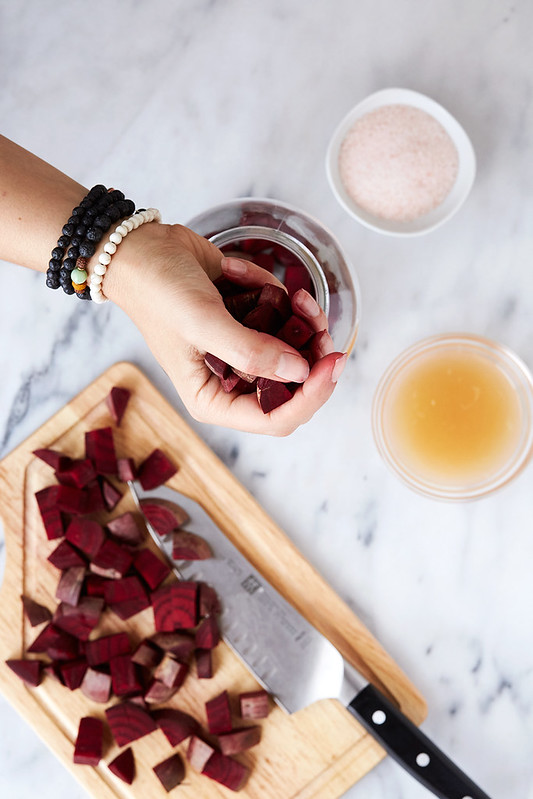
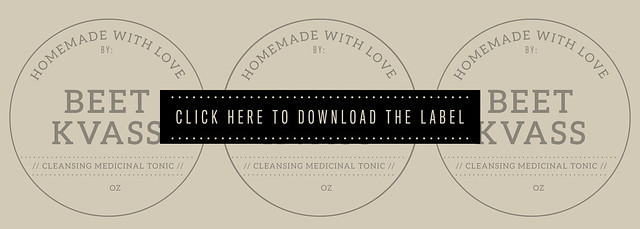


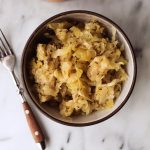

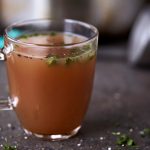








One Response
Can’t wait to make this and try it!